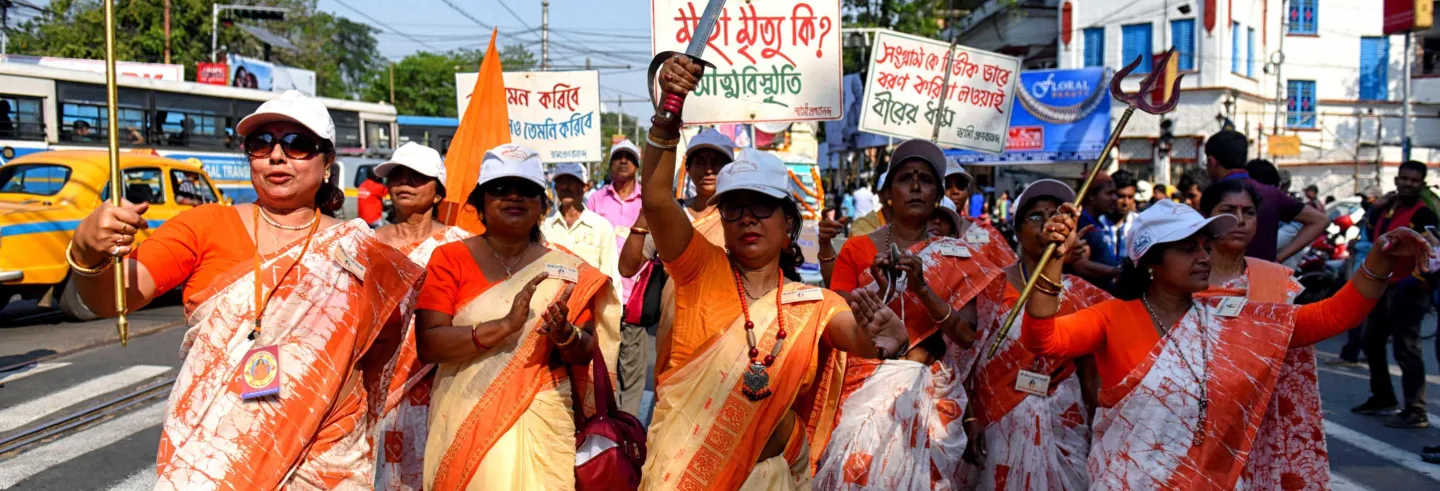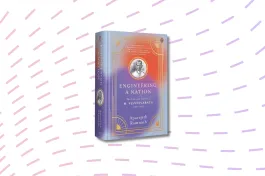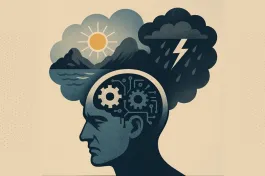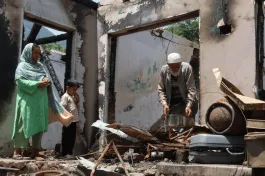One summer evening two years ago, thousands of people gathered on the grounds of Dum Dum’s Central Jail Maidan. The Lok Sabha elections were ongoing. Kolkata was bracing for the last round of West Bengal’s 7-phase election. Prime Minister Narendra Modi was about to deliver his last speech.
On a reporting assignment for the polls, I spoke with some people milling about at the rear of the rally. A man distributing blank postcards amongst the people handed me one. “Write Jai Shri Ram and drop it in the nearest post box,” he said. Stamped on the postcard was the residential address of Chief Minister Mamata Banerjee: 30B, Harish Chatterjee Road, Kolkata – 700026 (W.B.) As Modi’s helicopter whirred above, chants of Jai Shri Ram went up from the ground.
The Bharatiya Janata Party (BJP) had run a polarising campaign, labelling undocumented Bangladeshi Muslim immigrants as “termites and infiltrators,” and threatening to throw them out of Bengal if voted to power for a second consecutive term. Its sights set on Bengal, the party aimed to expand its footprint and place itself in a position formidable enough to dislodge the Mamata Banerjee government in the 2021 assembly elections.
Not enough attention has been paid to the Hinduisation of Bengali consciousness across class and caste, or the Left’s failure to take seriously caste-based discrimination.
The outcome of the 2019 polls did indeed catapult the BJP to the centre stage of Bengal politics. Taking its wins to 18 seats from two, the BJP fortified its position as the main opposition party even as the TMC tally fell to 22 from 34. The Communist Party of India-Marxist (CPI-M), which governed Bengal from 1977 to 2011, ended up with zero. After the electoral boost in 2019, an emboldened BJP went all out to retain its surge for the crucial assembly elections.
The keenly awaited, hard-fought election currently underway finds Bengal at a crossroad. The moment offers an opportunity to mull over some concerns that have been ignored for far too long. Within and outside post-independent Bengal, not enough attention has been paid to the Hinduisation of Bengali consciousness across class and caste, or the Left’s failure to take seriously caste-based discrimination and to ideologically counter the soft Hinduisation of its cadres and supporters.
The deep imprint left by Partition is connected to a longer history that suggests why large swathes of Bengalis have welcomed a Hindu Right party and endorsed its majoritarianism.
These narratives bleed into Bengal’s deeper historic legacies. The partition of Bengal in 1947 constitutes a critical moment that shaped popular mindsets and dominated socio-political discourse in the state. As historian Joya Chatterji writes at the outset of her book on the event: “The profound ways in which partition affected Bengal and India show how new borders help to shape the polities they circumscribe. What happened to the millions of Hindus and Muslims who found themselves on the wrong side of the Radcliffe Line which divided Bengal is a telling example of how partitions play havoc with divided peoples, in particular those relegated to the status of religious or ethnic minorities in new nation states.” (2007)
The deep imprint left by Partition is connected to a longer history that suggests why large swathes of Bengalis have welcomed a Hindu Right party and endorsed its majoritarianism with enthusiasm and alacrity. In this context, it is useful to explore some intellectual and political currents of the Hindu Right in the late-19th and early-20th centuries. In this period, thinkers and writers advocated the supremacy of Hinduism by demonising the West as the primary enemy of Indian culture.
Hindu consciousness as defined and projected by them played out on multiple registers, leading to a convergence of themes around social orthodoxy and religious supremacy. Regressive social norms were exalted and presented as authentic Hindu counters to reformist tendencies like the Brahmo Samaj and western education and culture. All this was subsumed within an idea of the supremacy of the Hindu religion. As social revivalism in this vein was intertwined with the politics of Hindu nationalism, the figure of the Muslim gradually took over from the West as the primary enemy.
Anxieties of otherness
The threat of being demographically overpowered by Muslims is an obsessive fear of Hindu majoritarian ideologues over the past century. In Bengal’s recent political stirrings, we see a revival of such demographic fears, anxieties, and resentments that over the years have formed what political scientist Pradip Kumar Datta calls “common sense communalism” (1993).
For example, U.N. Mukherji, author of a suggestively titled pamphlet called Hindus: A Dying Race (1910), projected a scenario of doom and extinction for the Hindu community. Citing census statistics, Mukherji argued that there would be a demographic overpowering of Hindus by Muslims. He invoked a warning by C.J. O’Donnell, Bengal’s census commissioner, who in 1891 calculated the number of years it would take for the Hindus to “disappear altogether from Bengal, if the Mohammedan increase went on at the rate it was doing.”
By deliberately excluding economically and educationally dominant upper caste Hindus from his framework, Mukherji could project Muslims as a dangerous and powerful Other.
Mukherjee, however, did not merely sound the death knell for Hindus by malignantly stereotyping Muslims as inferior. Somewhat counterintuitively, he valorised Muslims, projecting them as members of an ideal community. Mukherji praised the Muslim community for its exemplary dietary habits and willingness to adapt to any kind of work. He argued that the Muslim community was constructed around religious and moral practices and drew its strength from regular religious congregations and a consistent drive for self-improvement. Hindus, by contrast, were bereft of an equivalent idea of uplift. Mukherji urged Hindus to emulate Muslims and forge themselves into a well-defined, united, religious body. “Every Mahomedan, irrespective of wealth or position is a member of a religious congregation, where religious and moral teaching is regularly imparted and where he receives it,” he wrote. “Whatever superiority the Hindus possess or imagine they possess is confined to a small section of the community,” he cautioned.
Mukherji made Bengal’s lower castes stand-in for the Hindu community at large: a method that helped him contextualise the theory of Muslim superiority and the threat of Muslim domination. By deliberately excluding economically and educationally dominant upper caste Hindus from his framework, Mukherji could project Muslims as a dangerous and powerful Other.
A Dying Race subsequently became a template for Hindu ideologues to validate their arguments in favour of consolidating the Hindu community. Mukherji’s idea of extinction was eagerly taken up by Hindu organisations and leaders. In a speech delivered in Patna in 1925, for example, Arya Samaj leader Swami Shraddhanand described how he was “seized by the problem of the imminent extinction of Hindus, only after reading a book by one U.N. Mukherji.”
Though the notion of Hindutva is popularly associated with Savarkar […] Basu used the term almost three decades earlier, projecting the desire for a homogenous Hindu community.
Over a decade before Mukherji, in 1892, Chandranath Basu — a bhadralok — had published a Bangla tract titled, Hindutva, Hindur Prakrita Itihas (“Hindutva, the Authentic History of the Hindus”). Though the notion of Hindutva is popularly associated with Savarkar and his Hindutva: Who is a Hindu, Basu used the term almost three decades earlier, projecting the desire for a homogenous Hindu community. To him, orthodox Hindu marriage was an important marker of the Hindu way of life. In the name of preserving the sanctity of the Hindu social order, he defended patriarchal supremacy, gender inequality, child marriage, and the subjugation of the self. The Hindu social order, as Basu envisaged it, had no space for self-representation or individual expression. Moreover (though it was not surprising) these strictures of self and individual negation applied only to women.
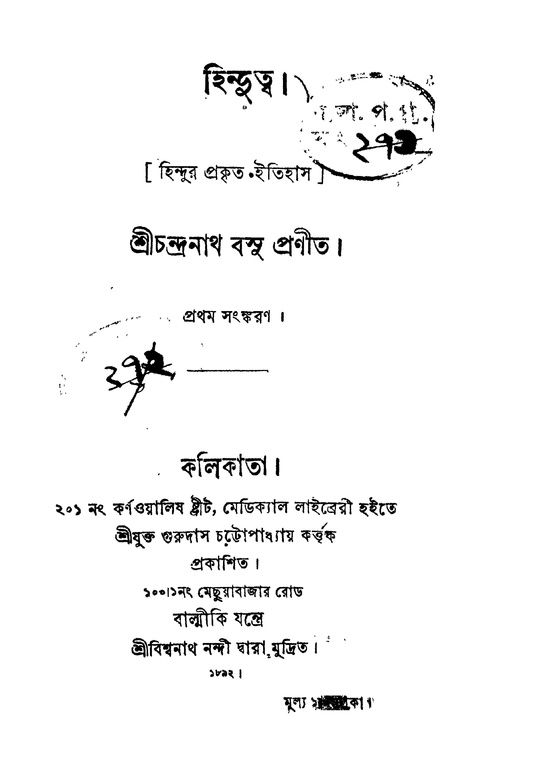
Basu’s defence of orthodox Hindu marriage, too, was pitted against ‘Western’ notions of conjugality. Reflecting that the West wanted to do away with the institution of marriage altogether, he cautioned that if transported to India, such an idea would devastate Hindu society. Basu’s Hindutva was very much an orthodox defence against the ‘West’.
The silent politics of caste
As the 19th century gave way to the 20th, the caricature of the enemy shifted more decisively from the West to the Muslim. As the desire to homogenise the Hindu community took hold, Hindu Right organisations began engaging with Bengal’s marginalised castes in a way the Left did not even contemplate doing till the late-20th century. The slow incorporation of lower castes within the Hindu fold went hand-in-hand with the steady expulsion of Muslims from the national body.
The Mahasabha and the Sangha worked on the ideological mission of keeping the Hindu community together.
Organisations like the Bharat Sevashram Sangha and Hindu Mahasabha played a crucial role in both processes, often providing what we can call intellectual justifications for such strategies. If Mukherji propagated demographic fears, the Mahasabha and the Sangha worked on the ideological mission of keeping the Hindu community together. This required preventing restless and assertive lower caste communities from breaking away from the dominance of the upper caste bhadralok.
Founded by Swami Pranabananda in 1917, one of the Sangha’s primary missions was urging Hindus to fortify themselves as an unbreachable, unified community. Such a mission called for an end to caste discrimination and the practice of untouchability. To achieve its ideological ends, Hindu organisations identified tribals and Dalits as their primary target groups. Pranabananda took the lead in setting up mobile preaching units across Bengal. Bedananda Maharaj, the author of Pranabananda’s biography, Sri Sri Yugacharya Jibancharit, described in great detail the mission’s execution. A huge boat and a massive palanquin were built to facilitate reaching areas of East Bengal with large Dalit populations. The campaigns, aimed at reorganising the village economy, carried out social work in backward areas.
Most Hindu Right leaders saw caste apartheid as a serious impediment to carving out a greater Hindu community.
Bedananda narrated that Pranabananda surprised “untouchable” Dalit communities by entering their houses and sharing food with them. During these decades, the Mahasabha and the Sangha invested a great deal of energy to get upper castes to jettison practices of ritual pollution and untouchability.
Most Hindu Right leaders saw caste apartheid as a serious impediment to carving out a greater Hindu community. Shyama Prasad Mukherjee, in his presidential address to the All India Hindu Mahasabha in 1944, said: “Our first and foremost social programme therefore must be the complete removal of untouchability and to regard every Hindu as enjoying equal social status.” Urging the Hindus to “take back all those who are prepared to return to our fold,” Mukherjee called for putting together a network of “vigorous centres” to spread the “true teachings of Hindu dharma — removing untouchability and imparting physical culture.”
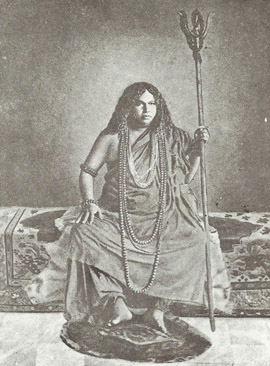
By 1926, the Sangha ran more than a dozen ashrams in areas of eastern and southern Bengal dominated by marginalised caste communities. The organisation founded Hindu Milan Mandirs, conceptualised on the lines of mosque gatherings, apart from launching Rakshi Dals comprising armed volunteers to defend Hindus against enemies. This movement for the assimilation of Hindus (Hindu Samanvyay Andolan) worked on multiple registers. The Hindu Milan Mandir provided spaces to hold prayers, conduct rituals and festivals, and deliberate on issues related to Hindu society. The young were taught history, the elderly given an education in the Shastras. There were libraries with books on Hinduism and the Hindu way of life. Schools of martial arts training were set up for self-defence.
A ubiquitous Hindu identity, proponents hoped, would steer groups away from caste antagonism and towards building a Hindu Dharma Rashtra.
Through the 1930s and 1940s, both the Mahasabha and the Sangha worked in tandem to fortify the Hindu community as one. Even as the BSS urged upper castes to end untouchability, it also asked lower castes to integrate themselves with the larger Hindu community by giving up their “hatred” of upper castes. These organisations wanted to direct Dalit anger at Muslims, representing them as the primary other and threat to Hindus. The Sangha’s spaces of Hindu congregation, Pranabananda believed, would facilitate organising as a homogenous, non-porous community. They served, or at least attempted to serve, the purpose of subsuming smaller oppositional caste-based identities into a sweeping fold of Hindu identity. Such a ubiquitous Hindu identity, proponents hoped, would steer groups away from caste antagonism and towards building a Hindu Dharma Rashtra. In some ways, the scale and operations of this intricate organisational network resembled the structure of the RSS, founded in 1925. During riots and famines, Hindu Milan Mandir volunteers would rush to the aid of Hindus, collecting monthly subscriptions and food from each member.
Dalit communities, on their part, challenged the idea of a homogenous Hindu society. To assert their political autonomy, they forged their own networks of alliances.
However, such attempts to integrate Dalits communities within the larger Hindu body were not without its challenges and contradictions. The bhadralok, suspicious of integrating marginalised communities within the Hindu fold, were anxious about their loyalty to the idea of a consolidated Hindu community. Dalit communities, on their part, challenged the idea of a homogenous Hindu society. To assert their political autonomy, they forged their own networks of alliances.
From the 19th century onwards, Bengal saw assertions by lower castes, in the form of social and political movements, or by expanding influences in the domains of education and economy. In the 1870s, the marginalised Rajbansis and the Namasudras launched social movements in the districts of north and east Bengal. In south Bengal, the Paundra-Kshatriyas began to organise themselves. In the Swadeshi period of 1905-1911, lower castes challenged the domination of bhadralok power structures. They stressed that they had little in common with upper-caste Hindus, and demanded privileges that at the time were accessed by Muslims. The Hindu nationalist, upper-caste, order had a vested interest in thwarting the possibility of any alliance between the marginalised castes, the “untouchables,” and Muslims, then a majority in Bengal.
Adopting agitational strategies, Dalit groups contested the caste-based power structures. The formation of the Bengal Provincial Scheduled Caste Federation in 1943, which advocated an alliance between Scheduled Castes and Muslims against Hindu domination, further sharpened the politics of contestation in Bengal. Powerful Dalit organisations were ready to challenge the Sangha’s work.
Scattered by the split of 1947, the major groups providing leadership to the Dalit movements remained outside of West Bengal.
Partition, however, dealt a body blow to organised Dalit movements. Scattered by the split of 1947, the major groups providing leadership to the Dalit movements remained outside of West Bengal. Regions that had cradled these movements were incorporated into East Pakistan. By the time Dalit leaders like Jogendranath Mandal and P.R. Thakur came back to West Bengal, after 1950, the political discourse was centred on refugee rehabilitation. In an additional setback to the movement, the upper caste leadership of both the Congress and the undivided CPI expelled the language of caste from the discourse around refugees even though, split along the axis of caste and privilege, they were far from being a homogenous community.
Contemporary legacies
Even as Hindu Right organisations penetrated subaltern castes, the Communist parties, maintained a studied silence on casteism. Refusing to acknowledge caste as an integral identity of Bengal’s political and social order, the undivided Communist Party of India (CPI) and, following the split in 1964, the Communist Party of India-Marxist (CPI-M), failed to provide a platform of redressal for the marginalised castes. The CPI-affiliated All India Kisan Sabha and the Bengal Provincial Scheduled Castes Federation rallied for the same cause: securing the rights of peasants to land. But they could not work together on a joint platform.
A blinkered vision prevented the Left from developing an organic connection with caste politics. By contrast, the Hindu Right adopted a deliberate strategy of promoting lower caste leaders.
Much like the Congress, the Left leadership continued to be dominated by the bhadralok. The Communist Party insisted on privileging class and ignored caste as a critical element of Bengal’s political and social dynamic. Such a blinkered vision prevented the Left from developing an organic connection with caste politics. By contrast, the Hindu Right adopted a deliberate strategy of promoting lower caste leaders to top organisational positions. Motivated though they were by the narrow ideological concerns of preventing lower castes from breaking away from hegemonic upper-caste sway, the Hindu Right’s campaigns against untouchability addressed some concerns around casteist discrimination.
What impact did the Left’s bhadralok leadership have on Bengal politics? How much did the CPI-M’s disavowal of caste politics contribute to the version of Bengal politics currently on display?
A brahmin from Bhatpara, wrote, “though [Kanti] Biswas had proven his skill, how could upper caste brahmins take lessons in education from a ‘chandalputra’”?
It is not that the Communist leadership was not aware of casteism. Kanti Biswas, West Bengal’s primary education minister from 1982 to 2006, shared his experience in an interview with the sociologist Sarbani Bandyopadhyay. Kanti Biswas belonged to the Dalit Namasudra community. His appointment to the education ministry riled the CPI-M’s upper-caste membership. Biswas told Bandyopadhyay that the party received hundreds of complaining letters. A certain Bhattacharya, a brahmin from Bhatpara, wrote, “though Biswas had proven his skill, how could upper caste brahmins take lessons in education from a ‘chandalputra’ [Son of a chandal — a slur used for lower castes]?”
It’s significant that the Left Front’s first cabinet in 1977 initially did not have a Scheduled Caste minister in it. This led the All India Scheduled Caste Federation to petition the CPI-M’s leadership. As Bandyopadhay told me, the then chief minister, Jyoti Basu, responded by saying that communists did not believe in caste. (Biswas was made a minister only four months afterwards, initially holding the youth services portfolio.)
The current upheavals in Bengal’s politics have dragged to the fore distinct, if less talked about, legacies of the Hindu Right that have shaped popular consciousness. As this slice of that past shows, these legacies are complicated. Among other things, the story of the Hindu Right in Bengal is a story of how Muslims became the primary antagonist for a Hindutva project which in its early days often envied Muslims out of self-hatred. The ‘West’ was the main enemy in that period, raising anxieties about cultural permissiveness, corruption, and the like. By understanding such intersections, we may develop a more nuanced and complicated sense of the changing political and social realities of Bengal. This understanding will take us beyond issues of governance to probe the psychological makeup of a state subject to many myths.


